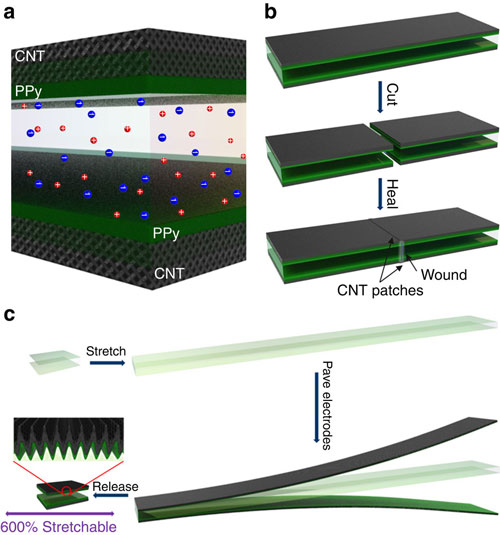| Posted: Feb 22, 2016 | |
Self-healing, highly stretchable supercapacitor based on a dual crosslinked polyelectrolyte |
|
| (Nanowerk Spotlight) Expect future wearable electronics to be fully integrated into clothes (e-textiles), work and sports gear, sensor band-aids, even tattoos. Considerable efforts have been dedicated to developing self-healable and stretchable electronic components that make these devices possible (see for instance our Nanowerk Spotlights ""Self-healing carbon nanotube supercapacitors" and "A magnetic-assisted, self-healing supercapacitor"). | |
| Previously, self-mending polymeric materials based on physical crosslinking or external stimuli – such as heat and light – have been successfully developed and employed for the mechanical recovery and electrical restoration of devices. | |
| In addition to an indispensable layer of electrolyte sandwiched between two electrodes, an extra layer of self-healing polymer is wrapped onto electrodes or used as a substrate for all self-healable supercapacitors reported thus far. | |
| "However, these devices have suffered from low healing efficiency and cyclability," Chunyi Zhi, an assistant professor in the Department of Physics & Materials Science at the City University of Hong Kong, tells Nanowerk. "After merely a few breaking/healing cycles (no more than 5), the capacitances decrease dramatically (14.3–28.2%). Another desirable feature missing in these devices is volume/mass economy owing to the use of an additional component, lowering the volumetric/mass capacitance." | |
| Given that not all electrocapacitive materials are intrinsically stretchable, various modified structures (for example, non-coplanar buckled, coplanar serpentine and wavy, percolating nanostructured) and electron/ion-inactive stretchable substrates (such as elastomers and stretchable textiles) have been utilized to introduce stretchability into conventionally rigid supercapacitors. | |
| However, most achieved strains did not exceed 100% and the performance usually deteriorated at super-high strains. | |
| "The low healing efficiency of self-healable supercapacitors and the small strain of stretchable supercapacitors are fundamentally limited by the widely used polyvinyl alcohol (PVA)-based acidic electrolytes which are intrinsically neither self-healable nor very stretchable," says Zhi. "This gives rise to unsatisfactory performance, the need for additional components, and complex multi-step design." | |
| "Therefore, it is primarily important to develop a multifunctional polyelectrolyte to realize intrinsic self-healability and high stretchability," he points out. | |
| A team led by Zhi has now developed a multifunctional polyelectrolyte, achieving an electrochemically complete self-healability and 600% stretchability of supercapacitors. This work can be applied to other energy conversion and storage devices such as batteries, fuel cells, etc. | |
 |
|
| Schematics of fabrication strategies for specific functional supercapacitors. (a) Schematic of the supercapacitor comprising the VSNPs-PAA polyelectrolyte and PPy@CNT paper electrodes. (b) Fabrication of the patch-assisted non-autonomic self-healable supercapacitor. (c) Schematic of the fabrication of a super-stretchable supercapacitor. (Reprinted with permission by Nature Publishing Group) | |
| The researchers have recently reported their findings in Nature Communications ("A self-healable and highly stretchable supercapacitor based on a dual crosslinked polyelectrolyte"). | |
| They fabricated a multifunctional polyelectrolyte with polyacrylic acid dual crosslinked by hydrogen bonding and vinyl hybrid silica nanoparticles. As the team demonstrates, this polyelectrolyte with tunable ionic conductivity can be easily stretched to greater than 3,700% strain and, once cut, can be simply self-healed by combing the broken interfaces in ambient conditions. | |
| "Movable protons in the polyelectrolyte provide an equivalent electrode capacitance compared with the commonly used PVA/H3PO4 electrolyte," explains Zhi. "It can be easily self-repaired at room temperature and the repaired samples show ionic properties similar to pristine samples after repeated instances of breaking and healing. In addition, it can be stretched more than 37-fold without any crack." | |
| In addition to the intrinsically self-healable polyelectrolite, the researchers used small patches of carbon nanotube (CNT) paper to overcome the well-known misalignment problem of self-healing supercapacitors. | |
| "Our study of the superior multifunctionality at the device level with facile fabrication and the fewest components creates considerable potential for the wide-scale application of multifunctional devices in many fields such as energy storage and biomimetic sensing," concludes Zhi. | |
 By
Michael
Berger
– Michael is author of three books by the Royal Society of Chemistry:
Nano-Society: Pushing the Boundaries of Technology,
Nanotechnology: The Future is Tiny, and
Nanoengineering: The Skills and Tools Making Technology Invisible
Copyright ©
Nanowerk LLC
By
Michael
Berger
– Michael is author of three books by the Royal Society of Chemistry:
Nano-Society: Pushing the Boundaries of Technology,
Nanotechnology: The Future is Tiny, and
Nanoengineering: The Skills and Tools Making Technology Invisible
Copyright ©
Nanowerk LLC
|
|
|
Become a Spotlight guest author! Join our large and growing group of guest contributors. Have you just published a scientific paper or have other exciting developments to share with the nanotechnology community? Here is how to publish on nanowerk.com. |
|
